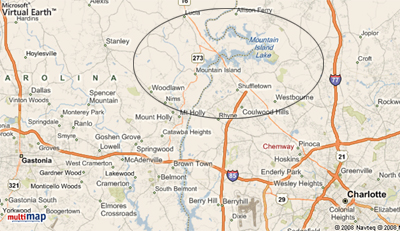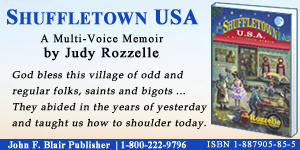I own a cemetery and it is occupied by relatives. This might seem like a strange sort of investment holding, but there’s nothing untoward here. I had nothing to do with the demise of any of the relatives, and the cemetery is not in my backyard beneath the rose bushes. Instead, it is unmarked and obscured in deep woods. This dear piece of earth came to me through a quick claim. I was fortunate enough to be hired for a research project. I needed money. I certainly never had any intentions of acquiring said cemetery.
In the fall of 2002, I convinced a friend to hire me to research the history of the Riverbend community. Well, one thing led to another, and in the spring of 2003, I drove to the Gaston County Courthouse, gave the Clerk of Court the filing fee, signed my name on a deed and became the owner of an old and ancient graves. Through a curiously circuitous journey, I was led to these forgotten relatives.
During my history project, I interviewed everyone I could find who would sit and answer questions about Riverbend, including the peninsula historian, Calvin Hart. Calvin knew someone who had an old map of the peninsula. Another person came up with letters and photos of the old Henderson place, and the location of the Henderson ferry which took them across the river to one of the area’s first church, Hopedale on Beatties Ford Rd. I read the tombstones in the Lineberger Cemetery at the end of the peninsula. I spent days shuffling through the archives in the Lincoln County Museum.
I met cousins, grandparents, uncles, and aunts, most of who were dead. I read about ancestry that claims blood kin from Pocahontas and Norman Vikings. Family legend states that John Abernethy, one of the first pioneers to ford the Catawba, arrived from Virginia, and told that one of his grandmothers was Pocahontas. I read of a relative who died in a duel, another was appointed to a government office and when he was excused from the office, he refused to leave.
In Gaston County records there is a reference to an Abernethy family operating a ferry in 1764. This same ferry would be purchased in the next century by Richard Rozzelle, my great, great, and great-grandfather.
Among the early pioneers were Jacob Forney (arrived in 1752) followed by multitudes of new back-country settlers. Among the next wave were the families of Johnson, Mauney, Alexander, Abernethy, McCorkle, Cansler, Rhyne, Hoke, Lineberger, McLean, Howard, Reid, Reinhardt, Reep, Warlick, Chronicle, Dellinger and Ramsour. The Dutch pioneers arriving from Pennsylvania to settle along the Catawba were from the Palatinate Region of Germany. The Scots-Irish were peasant from the Plantation of Ulster.
It was in a conversation with a friend that sent me in search of a forgotten graveyard. I followed my instincts and parked along a country road one bright fall day…I entered the woods looking for a “supposed” cemetery. Leaves crunched beneath our footfalls. Unseen mourning doves called from the brush, periwinkle carpeted the ground, and the trees were thicker than rush-hour traffic. My feet were deep in leaves dropped by many fall seasons, it was quiet. It was spooky. I glanced into the trees one last time before turning back. Suddenly, I saw five tombstones standing among the trees.
These moss-covered slabs marked the final resting place of the first pioneer families to carve out hoe on the Riverbend Peninsula. More than one grave was sunken and most tombstones were broken, scattered, and in various states of disintegration.
Among the tombstones are all are proof of lives that are now long forgotten. James A. Henderson (b. 1796-d. April 18, 1888) rests here as does his wife, Linia Parr Abernethy (b. 1811-d. November 20, 1888). Beneath the fourth tombstone lies their daughter, Mary Adeline Craig, wife of S. W. Craig. Mary was born in 1831 and died April 20, 1855, one month after giving birth to her daughter, Mary Laura Elizabeth Craig.
James and Linia doubtless made many sad pilgrimages to this graveyard. They buried two sons, William Adolphus Henderson (b. 1842 d. 1862), James Lawson Henderson (b. 1839 d. 1864) and their granddaughter, Mary Laura Elizabeth Craig (b. March 5, 1855 d. 1868). Mary Laura Elizabeth was only thirteen at the time of her death. James and Linia Henderson carried on with the task of living for more than 20 years before they joined their children in the cemetery.
According to a letter written by James Abernethy Henderson on September 19, 1962, James Abernethy, one of Henderson’s ancestors, arrived in the Riverbend/South Forks area in the summer of 1769. He traveled to the area with his brother-in-law, Robert Abernethy, Jr. and Robert’s wife, Sarah Abernethy. Robert’s elderly parents were traveling with them as were his two brothers, David and Miles Abernethy, James was known in the family as Cousin James.
They crossed the river at Beatties Ford and settled on the western banks of the
Catawba River. The letter further states that James married Elizabeth Cox Abernethy and they were the parents of seven children. Among the children was a set of twins, Elizabeth and Mary who was nicknamed Polly.
Elizabeth married William Henderson. They had 10 children. Their first born child was James A. Henderson who rests by his wife, Linia Abernethy, daughter of Miles and Susan Paar Abernethy. Her sister, Mary (Polly) Abernethy married Richard Rozzelle and they had six children.
Richard and Mary Rozzelle settled on what became Old Plank Road and were neighbors of Anna Morrison, wife of Civil War legend Stonewall Jackson. Though the Jacksons lived in Virginia, Mrs. Jackson settled in the Charlotte area after the war.
The landscape changes, and decades pass, but as each generation births a new generation into their life’s journey to experience laughter, contentment, and tears; mortgages, weddings, and wars; ancestors are forgotten. If we do not know our history, our forefathers, if we erase history; how will we know who we are?
“Think of all that has happened here, on this earth. All the blood, hot and strong for living, pleasuring, that has soaked back into it.” William Faulkner, “Big Woods”



